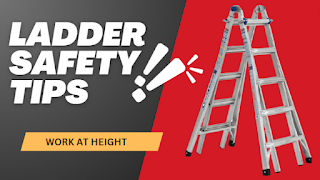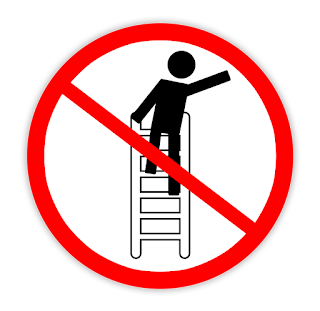Working at height is one of the most hazardous activities in the workplace, with falls being a leading cause of serious injuries and fatalities. Ladders are frequently used in a variety of industries for tasks such as maintenance, construction, and inspections. While ladders are simple and convenient tools, they pose significant risks if not used correctly. Ensuring ladder safety is paramount to preventing accidents and protecting workers.
This blog post delves into the essential practices for
ladder safety, focusing on selecting the right ladder, proper setup, safe
usage, and maintenance.
Understanding the Risks of Ladder Use
Before discussing safety practices, it's important to understand the risks associated with ladder use. The most common accidents involving ladders include:
1. Falls from height: The most severe and common type of
ladder accident, often resulting in serious injuries or fatalities.
2. Ladder slippage: Occurs when the ladder base loses grip
on the surface, leading to a fall.
3. Structural failure: Caused by using a damaged or
overloaded ladder.
4. Overreaching: A worker extends too far to the side,
causing the ladder to tip over.
5. Improper ladder setup: Setting up a ladder on an unstable or uneven surface increases the risk of a fall.
These risks highlight the importance of adhering to ladder
safety guidelines to prevent accidents and ensure a safe working environment.
Selecting the Right Ladder
Choosing the appropriate ladder for the task at hand is the first step in ladder safety. Here are some key considerations:
1. Ladder Type: There are different types of ladders designed for specific tasks. For example, step ladders are ideal for tasks requiring stability, while extension ladders are suitable for reaching higher places. Ensure you select the ladder type that matches your work requirements.
2. Ladder Height: The ladder should be tall enough to reach the desired height without the need to stand on the top rungs, which is unsafe. A general rule is to ensure that the ladder extends at least three feet above the point of support when using an extension ladder.
3. Weight Capacity: Ladders are rated based on the maximum weight they can safely support. Consider the combined weight of the user, tools, and materials when selecting a ladder. Never exceed the ladder's weight capacity.
4. Material: Ladders are made from various materials such as wood, aluminum, and fiberglass. Choose a ladder made of non-conductive material like fiberglass if you are working near electrical hazards.
Proper Setup of Ladders
Once the right ladder is selected, proper setup is crucial to ensure safety. Follow these guidelines:
1. Inspect the Ladder: Before using a ladder, inspect it for any signs of damage, such as cracks, bends, or missing parts. Never use a damaged ladder.
2. Stable Surface: Place the ladder on a stable, level surface. Avoid setting up a ladder on slippery, uneven, or soft ground. If necessary, use a ladder stabilizer or anti-slip device.
3. Secure the Base: Ensure the ladder's feet are firmly planted and do not move when pressure is applied. On hard surfaces, non-slip feet are essential to prevent the ladder from sliding.
4. Correct Angle: The ladder should be positioned at the correct angle of 75 Degree to prevent it from tipping over. The 4-to-1 rule is a useful guideline: for every four feet of ladder height, the base should be one foot away from the wall or structure.
5. Three Points of Contact: Maintain three points of contact (two hands and one foot, or two feet and one hand) while climbing or descending the ladder. This ensures stability and reduces the risk of falling.
6. Top Support: When using an extension ladder, ensure it rests against a stable surface, such as a wall, and that the top is secure. Avoid placing the ladder against weak surfaces, such as windows or gutters.
Safe Ladder Usage
Even with the correct ladder and proper setup, how you use the ladder significantly impacts safety. Here are some best practices:
1. Face the Ladder: Always face the ladder when climbing up or down. Climbing with your back to the ladder can lead to loss of balance and falls.
2. Use Both Hands: Keep both hands free to hold onto the ladder when climbing. If you need to carry tools or materials, use a tool belt or haul them up separately with a rope.
3. Avoid Overreaching: Keep your body centred between the ladder's side rails to prevent tipping. If something is out of reach, climb down and reposition the ladder instead of stretching too far to the side.
4. Don't stand on the Top Rungs: The top two rungs of a ladder are not meant for standing and are unstable. Standing on these rungs increases the risk of tipping over.
5. Avoid Climbing in Bad Weather: Wet, windy, or icy conditions make ladder use extremely hazardous. Postpone ladder work if the weather is unfavourable.
6. Limit Time on the Ladder: Prolonged periods on a ladder can lead to fatigue, increasing the risk of falls. Take regular breaks if you need to be on the ladder for an extended time.
7. Work with a Partner: If possible, have someone hold the
ladder while you work. This adds an extra layer of safety and can be crucial in
preventing accidents.
Ladder Maintenance and Storage
Proper maintenance and storage of ladders are often overlooked but are essential for safety. Here are some tips:
1. Regular Inspections: Perform regular inspections to identify wear and tear, especially if the ladder is frequently used. Replace any damaged parts immediately or retire the ladder if it is beyond repair.
2. Clean the Ladder: Dirt, grease, and other debris can make ladder rungs slippery. Keep the ladder clean to ensure a secure footing.
3. Proper Storage: Store ladders in a dry, cool place away from direct sunlight. Prolonged exposure to heat or moisture can weaken ladder materials.
4. Avoid Overloading: Never use the ladder to support more weight than it is rated for. Overloading can cause structural failure and lead to accidents.
5. Follow Manufacturer Guidelines: Always follow the manufacturer's instructions regarding the use, maintenance, and storage of the ladder. This ensures you are using the ladder as intended and reduces the risk of accidents.
Conclusion
Ladder safety is a critical component of working at height,
and adherence to safety practices can significantly reduce the risk of
accidents. By selecting the right ladder, setting it up correctly, using it
safely, and maintaining it properly, you can protect yourself and others from
potential harm. Remember, no task is worth risking your safety, so always
prioritize ladder safety in your work routines. Safe ladder use not only
prevents injuries but also ensures that your work is completed efficiently and
effectively.




![How to Complete Part 3 [Prioritise 3 actions with justification for the selection] of the IG2 Risk Assessment](https://blogger.googleusercontent.com/img/b/R29vZ2xl/AVvXsEhcQwvFuxbzNnLuPJFUi-hQGm80NPnuH67qjg3FBFcaN0MVZ1MLPE-q_y25sBixuKAMhd7nCH5juYA2OATZb0u0XAu6BUqLe5FoyoTRfmizSRCzZd7oLUbQkprGWvP8qfwo6meJQtbFafsb8t4Rv_zUS3YYp5LcNXnVePzROt05VH-Qe8QrVDdBvoIRRckE/w680/Part%203%20%5BPrioritise%203%20actions%20with%20justification%20for%20the%20selection%5D%20of%20the%20IG2%20Risk%20Assessment.png)
![How to Complete Part 2 [Risk Assessment] of the IG2 Risk Assessment](https://blogger.googleusercontent.com/img/a/AVvXsEh6yMgcw8yvUN3jWgXUVDO3YWFWb94KkOuAh7fjUNfLO7duOOW6ky_BHCGmaQn1i67UF7W-ugVuoDlejNCCJxkWpHPkQ5tAKbVYIHHR_EL4bXx_QJgCTT0TsSKG1sniYMeMYwAMYL7-997X0UreTGaThE20tbOPKWMjGJ9mctUWBWfIdFP9O1aAE51ihPpG=w680)



